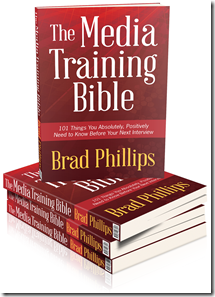Reader Question: Can You Clarify Your Advice On Bridging?
I recently received this email from a communications consultant working in Brussels, Belgium. She writes:
“I bought your book a couple of months ago and found it a terrific read. I give a great many media trainings a year and found inspiration for a couple of improvements of the way I train my clients.
I do have one question / remark. You present the proof points of the key messages as messages to bridge to. But should a spokesperson not be bridging to key messages in lieu of proof points? I always tell my trainees to repeat key messages a couple of times during an interview (not word for word of course).
Scientific research shows that a minimum amount of repetition is useful for a message to sink in with an audience (print interviewer) and besides if you repeat a key message a couple of times (A/V interview) you increase the chances of it being selected by the editor for the final cut of the report. What is your take on this?”
She is referring to my advice to bridge—or transition—not only to your core messages, but also to “message supports” such as stories, statistics, and sound bites.
First, she is right—repetition increases the likelihood that a message will be used by the media and remembered by the public. Upon reading her email, I quickly concluded that the advice we’re both offering our clients is compatible, not contradictory.
The system I developed for answering questions—described in The Media Training Bible as the “message support stool”—was designed to get around a problem that tends to affect (and afflict) longer interviews.
As I assert in our training sessions, reporters and the public resent a spokesperson who simply regurgitates the same messages repeatedly. Therefore, the problem I wanted to solve was this: How can a spokesperson answer every question in a manner that conveys their main themes but without ever lapsing into the kind of obnoxious repetition that repels an audience?
The idea behind the message support stool—or “proof points,” as supporting material is sometimes called—is that you can supplement your main messages by occasionally expressing them through a story, statistic, or sound bite. Beyond simply preventing repetition, a well-curated story, statistic, or sound bite can be more memorable than the main message itself, which is often an abstraction or more conceptual idea.
But I agree with her that it’s a good idea to come back to the main messages themselves at least a couple of times throughout the interview, using different words each time, as she suggested. That’s important for the reasons she stated, but I’d add one more reason.
During longer radio interviews, for example, the audience may turn over a few times. In other words, a person listening at the beginning of an interview may not still be listening at the end, and many people may have tuned in sometime during the middle of the interview. Therefore, repeating your message a few times is the only way to ensure that each listener hears your most important points at least once.
Thank you very much for your thoughtful question!
Do you have a question about media interviews or public speaking that you’d like answered in a future blog post? Please email me at info@throughlinegroup.com.




